Guest blogger Natalie was apprehensive about taking her young family on a bikepacking holiday. The logistics seemed impossible and the barriers overwhelming. After a moment of courage, Natalie faced her fears and planned a mini bikepacking trip with her children. Natalie shares why she changed her mind and what she learned along the way.

Natalie had reservations about how challenging bikepacking with children would be, but a mini bikepacking adventure together completely changed her mind. Photo: Natalie Martin
A few years ago, I would’ve looked at families who went bikepacking and called it a holiday with great suspicion.
I’d be thinking, where did they get these children who’ll willingly spend as much time getting to their destination as being there?
How do they manage without all the stuff you need to take on holiday? What if it rains? Why bikepack anyway?
Flash forward to 2022 and I’ve just returned from our first mini bikepacking adventure.
I went with my husband and two children aged 8 and 11, and we all want to do it again.
Time for a change
So why did I make such a U-turn on bikepacking?
Well for starters, we’ve not travelled by plane since 2009 because of the climate crisis, and since the pandemic we’ve not been abroad by any means.
This meant I’ve been looking for adventures closer to home for a while, and ones that wouldn’t need us to use the car too much either.
I also felt this year that our children have reached an age where they are both capable of doing more adventurous things.
I’d read articles about other people bikepacking with their children and thought how liberating it sounded, if only I could get my head around the logistics.
Eventually, a moment of courage struck me and I realised it was about time that I tested my fears to discover how founded they really were.
With that decision, our mini-bikepacking holiday was planned.
1. The holiday starts from the moment you leave the house
I’ve always enjoyed setting off on holiday but long car journeys with children can very quickly lose their appeal.
Providing entertainment, finding toilet stops, suffering dirty fuel stations, mediating squabbles, negotiating traffic jams, managing travel sickness and fidgeting in seat belts.
Consequently, it never felt like the holiday had started until these hurdles were overcome.
Not so with bikepacking, the adventure began from the moment we shut the front door.
From the word go, we all felt invigorated to be powering our way towards our destination.
Cycling brought a whole new level of connection with the places and landscapes we passed through.
The journey became part of the holiday, something to be enjoyed and not rushed.
Top tips:
- Planning our route in advance gave us a sense of calm.
- We used the Ordnance Survey app, Google street view and aerial maps. Plus some photos in Google maps were able to give us an idea of the terrain in areas which weren't covered by Google's camera car.
- We factored in some time for delays. We didn’t have any punctures, but we did have a delayed train.
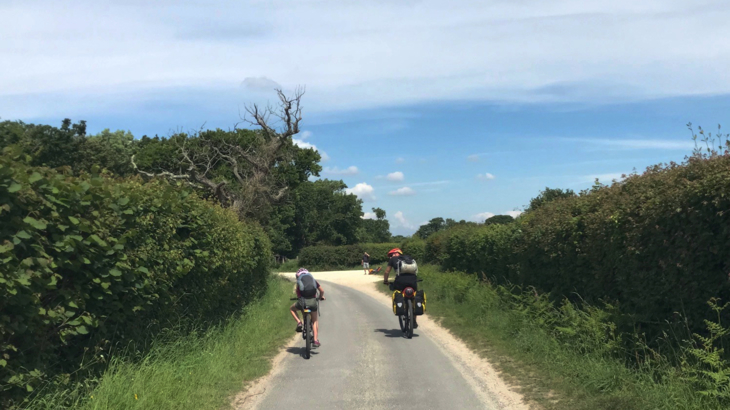
With no stressful car journey to endure, Natalie loved how the holiday began from the moment she shut the front door. Photo: Natalie Martin
2. The sense of freedom is empowering
We really were free to go wherever we chose and stop whenever we liked.
We never felt restrained or limited as we would do in the car by traffic jams, infrequent service stations, long stretches between motorway junctions and looking for car parking spaces on arrival.
My fear of not having a car quickly disappeared as I embraced that freedom.
Even rain didn’t put us off, the sense of achievement from having survived the elements made us feel like heroes.
Top tips:
- Bikes with tyres which are suitable for off-road terrain helped to widen our range of route options. I cycled a hybrid bike on this trip and the rest of my family had mountain bikes. The children fared better on gravel tracks than me.
- Good waterproofs and dry bags kept us and our kit dry.
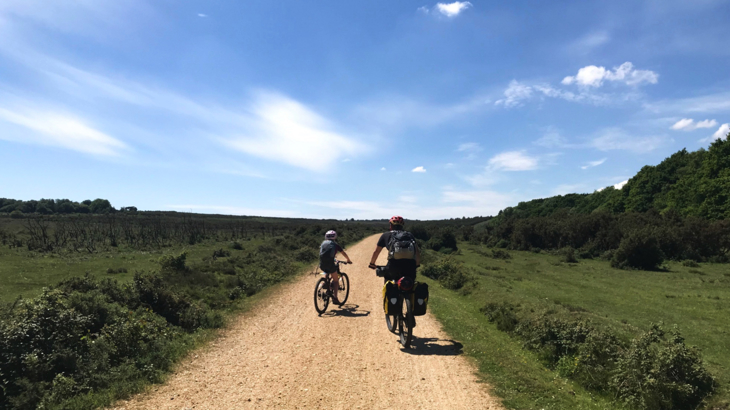
Natalie said waterproofs and dry bags gave her family the confidence to know that even if the sun stopped shining, their journey would continue in all weathers. Photo: Natalie Martin
3. Taking bikes and children on trains is not that scary
I had really exaggerated this worry in my mind in the days before we set off.
Despite being very comfortable taking a bike on a train by myself, I had visions of leaving a child stranded on a platform, unable to get on a train.
Whilst it’s true that the provision for taking cycles on trains should be improved in the UK, my fears did melt away after the first time we boarded a train together.
The train doors were wide enough for our bikes, even when they were laden with panniers.
We also felt seen by train staff as we loaded our family and bikes on and off, so there was no fear of the train pulling away whilst we were mid-manoeuvre.
The racks that we found on the train were designed for three adult bikes, but we managed to fit our four, plus panniers, and the guards seemed to turn a blind eye.
Top tips:
- I recommend checking in advance who in your group can lift the front wheel of their fully-loaded bike and who can’t. We found that if the front wheel could be lifted onto the train, the rest would follow with a push. Knowing this in advance will make getting your bikes onto the train much easier, as you can all decide on your different roles in advance.
- We travelled outside of rush hour and this made our train journeys nice and calm.
- If you look for the (sometimes small) bike symbol on or next to the train doors, you can see where the cycle parking spaces are located and which doors to use.
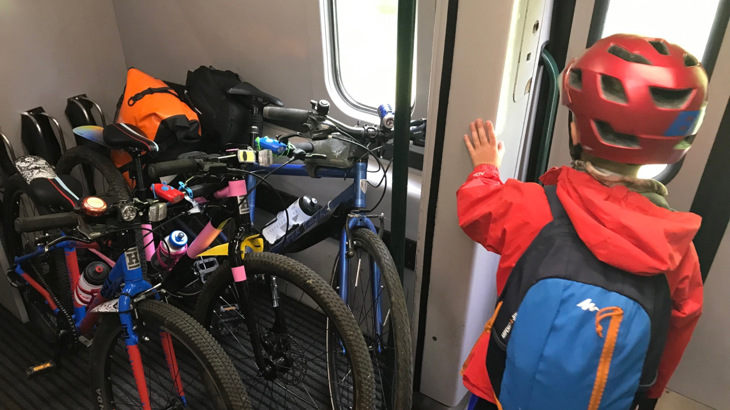
Natalie's family quickly established an efficient routine for getting on and off trains safely. Credit: Natalie Martin
4. Freedom from ‘stuff’ is liberating
I confess, I’m usually guilty of packing the car with everything we could possibly need.
Even with an estate car, we’ve been known to ‘need’ more storage on the roof rack.
I guess all our stuff was just a safety blanket which bikepacking forced me to let go of.
After all, we couldn’t possibly lug all our worldly belongings around with us.
An essentials-only rule meant no toys, no multiple changes of clothing, no selection of kitchen gadgets and not bringing the entire medicine cabinet.
To be honest when we got to the campsite, I was a little disoriented.
Unpacking took no time at all and I wasn’t sure what to do with myself.
Then a moment of dread hit me as I wondered how on earth we’d entertain our children without their toys and games.
It took them all of five minutes to start playing leapfrog, climbing trees, messing around with sticks and looking for bugs.
We walked, watched local wildlife, chatted and stargazed.
And there were no arguments over who had what stuff, who had to tidy it up, or who had put what where. Bliss.
Top tips:
- We found that travelling light with a finite number of bags meant that it took quite a lot of time to pack. It was a fine art that improved with practice. I suggest doing some trial runs. This helped us to get a feel for our luggage weight and size on the bikes and challenged us to question how much we really wanted to carry certain items.
- As this was our first bikepacking trip, we didn’t want to commit to buying a lightweight family tent, so we booked a campsite where we could hire a tent instead.
- Despite all of the kit rationalisation, I found that waterproof footwear was essential to prevent wet-feet-misery.
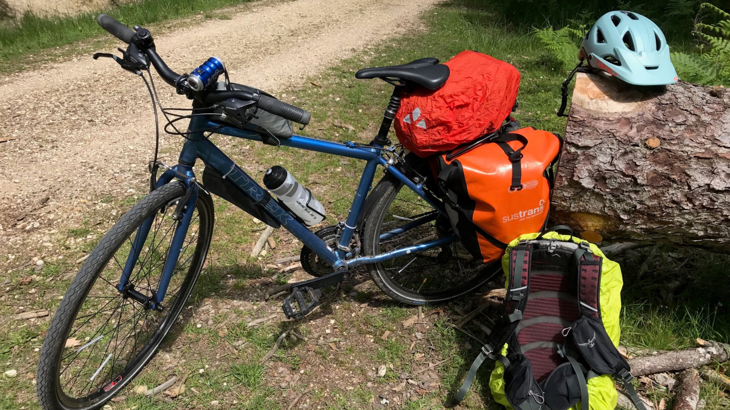
Carrying only the bare essentials left Natalie wondering how she would entertain her children. She needn't have worried as they soon discovered the joys of nature. Credit: Natalie Martin
5. Children are more capable than we give them credit for
We cycled a total of 19km on our outbound journey and 21km on our return.
Our children are not immune to complaining about having to move themselves by pedal power or on foot, even for short distances.
But on this trip, they totally outperformed themselves and could have cycled a lot further.
That said, as a first effort, I’m glad we cycled them well within their limits.
By making time to travel at the children’s pace, we were able to indulge in stopping frequently to enjoy our journey.
We made lots of impromptu pauses, checking out a park, identifying wildflowers, and listening to birdsong.
I wasn’t expecting our children’s sheer joy at this adventure.
It was infectious and they powered us all along.
Top tips:
- I topped up my children’s energy levels with frequent snacks. And some edible treats that we don’t always green light at home acted as great incentives when needed. Stops for cream teas worked very well for me.
- Initially, my temptation was to load all the luggage onto my and my husband’s bikes, helping the children to cycle as far and as fast as possible. But a change of heart meant we decided to give them some small things to carry. I’m glad we did, it helped them to feel useful and part of the team.
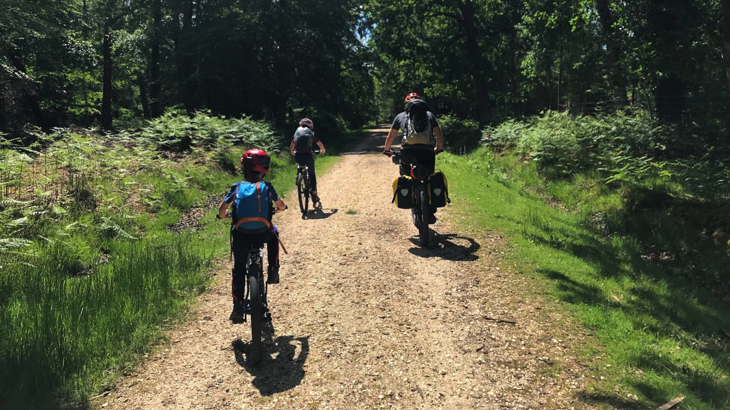
Carrying some of the luggage helped Natalie's children to feel part of the team. Credit: Natalie Martin
What's next for us?
The children have asked if they can now cycle the 250km to their grandma’s, so we might need to build up to that.
However now we’ve dipped our toes in bikepacking, it feels like the world is our oyster.
There's talk of Paris and the Netherlands, and why not?
A little more planning, a little more packing, but we are ready for the challenge!





